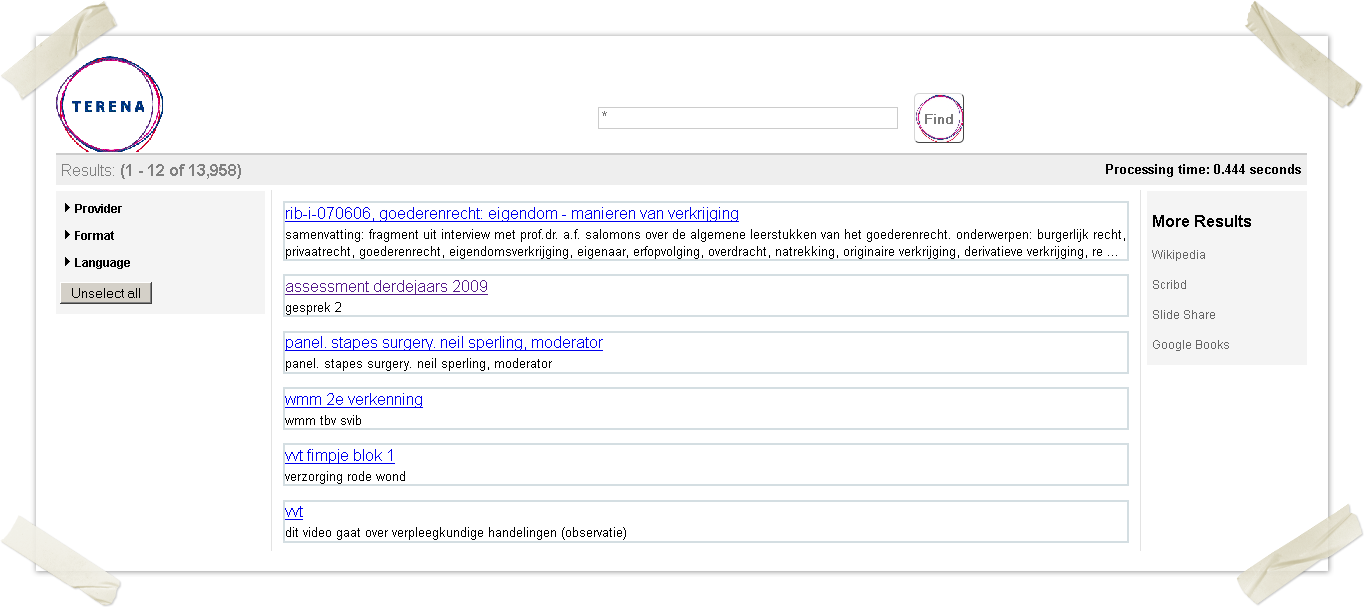...
- Vicente (UVigo) gave a brief introduction to DSpace. DSpace is being used at University of Vido as as institutional repository.
- Professors are not really keen on searching materials in the repository, though. They prefer Google, perhaps because they only know Google.
- Stepping up from the institutional level to the national and pan-European level might help promoting better our content repositories. Filling the gap between the national level and the global level is the major role of the TERENA OER.
- TERENA OER can have value added benefits compared to Google search, such as the deeper search in metadata and the clearly licensed materials. Creative Common licensing is the potential way forward, must be added to the portal in the future.
- Eli (IUCC) commented that the service provider view is different from the end-user view. TERENA OER must be considered as a provider. Links between objects, information about who searches for what, who comments on what, etc. are all very important for the provider.
- Vicente (UVigo) noted that from the end-user point of view, added features such as embeded video player to the portal or mosaic thumbnail representation of the targets are important. Must be considered in a later phase as enhancements.
- DSpace is only used for aggregation, no content enrichment in included. It is about the enrichment of the user experience and not the enrichment of the content itself.
- Vicente (UVigo) summarized that the DSpace-based implementation is better for institutional purposes rather than for a pan-European aggregation portal. He will contribute to the pilot with valuable comments from the end-users perspective.
- It was agreed to drop the DSpace-based option!
3.) ARIADNE-based pilot portal installation done by GRNET: http://83.212.100.142:8080/terena-finder/?query=*
- Giannis (GRNET) stressed that the common metadata format and the agreement on the minimum set of metadata is important. Analysis of the metadata schemes is needed!
- Giannis will set up a mini-survey for the metadata analysis (5 questions) that can be discussed and sent out to the repository owners.
- To prof the concept, GRNET implemented an ARAIDNE-based pilot portal without engagement with the providers and without proper analysis of the harvested metadata. The OAI-PMH targets were harvested automatically from 2 providers (one Dutch and one Polish).
- Giannis demonstrated the pilot portal installation based on ARIADNE (see the screenshot)
- As it can be seen from the results, the automatically harvested metadata has poor quality. Not sufficient for a pan-European aggregation portal purposes. It has been proofed and agreed that extensive metadata analysis, common metadata set agreement and engagement with the repository owners (i.e. providers) is needed.
- ARIADNE is only a specification and a set of protocols; a software stack to harvest and index metadata. It has a GoogleSerach-like user interface at the moment.
- The modular architecture helps to add new services to the portal easily.
- Peter (TERENA) said that the initial idea was to compare the MAOR-based and ARIADNE-based implementations, evaluate them with the criteria of a pan-European portal in mind, and implement the TERENA OER pilot portal based on the wining platform. Eli and Giannis commented that the two tools can even be combined as some of the features can nicely complement each other.
- Eli said that e.g., ARIADNE can be used to harvest metadata automatically from the internet (open PMH targets, YouTube channels) while MAOR can be used to harvest metadata from the national repositories engaged with the portal.
- It was agreed to dedicate the next coming meeting of the group to the discussion about how the two platform implementation can be combined.
- Peter (TERENA) will set up the next meeting and send out the open invitation to the TF-Media group.
***
